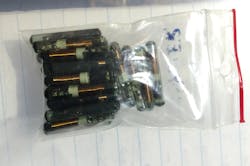The average aftermarket automotive or motorcycle plastic head transponder equipped key blank costs from under $10 to more than $50. Mis-cutting an original equipment (O.E.M.) transponder key blank hurts, as it can cost more than $100.
Expanding automotive services means purchasing a larger stock of transponder key blanks for your service vehicles and shop. To lower costs and maintain sufficient stock, some automotive transponders can be recycled. Transponders can be harvested from worn, broken, unwanted, mis-cut or even new plastic head transponder-equipped keys. Transponders cannot be harvested from most circuit board-equipped vehicular keys as the transponder is integrated into the board. As far as I am aware, this is correct except for Honda.
Key wear and breakage are two good reasons for harvesting transponders. Here are a few examples. Pontiac vehicles using the PK3M transponder keys, such as the 2000-03 Grand Prix are subject to breaking because this key is used to operate the trunk lock. Early Nissan, Toyota and Ford vehicles seem to have sufficient key wear, which results in breakage as the keys will no longer turn in the locks. Honda transponder keys break because of premature lock failure.
Transponders can be harvested from these broken keys and installed into a chipless key blank. The hard part is getting the customer pay for replacing the wafer tumblers or replacing the lock to eliminate the problem at least for a limited time if it is a Honda.
The Texas Instruments 40 bit transponder has been discontinued. The chips are sold out and key blank stocks are running low. The 80 bit transponder is backwards compatible to many ‑ not all ‑ 40 bit technology vehicles. However, a number of the Mazda (Ford) vehicles equipped with the 40 bit technology will not accept an 80 bit transponder if there are some programmed 40 bit transponders. This is one reason why the price of the 40 bit transponder-equipped Ford/Mazda key blanks is increasing in value.
There is a work around. Use the eraser procedure in your programming device to remove all transponder values from the vehicle. Then, use your programming device to program two 80 bit transponders. The remaining 40 bit keys can be on-board programmed.
However, not all recycled transponders can be programmed to a different vehicle. This is the part that gets difficult. With transponder chips, nothing is always or never. A specific year, make and model recycled transponder chip may work most of the time or very rarely. This is why you never glue the sleeve/carrier into the head until the key has been tested a few times.
Let’s begin with a few recycled chips that for most locksmiths do not recycle. They include the circle + (General Motors) and most Chrysler transponder chips. For all practical purposes, this chip is relatively inexpensive and not worth attempting to unlock. For more information on purchasing transponders, contact the companies at the end of this article.
The best way to determine if a transponder is programmable is to check it with a cloning machine that displays the pertinent information. Remember the cloning machine will read the key using the manufacturer’s terminology.
For this article, I was given access to a JMA USA TRS5000 EVO. The TRS5000 EVO has four lines, 20 characters per line display. When a transponder is read, the display indicates some or all of the following: "TP" (transponder) number, the transponder description, which generation, vehicle manufacturer, JMA USA clonable transponder part number, identification and transponder-specific information.
For a Ford H92-PT aftermarket transponder key, the transponder is a TP33 Texas Crypto Copy on TPX2/TPX5 PW 03 ID MC 01 and in the bottom, right corner of the display, DST80. DST80 indicates an 80 bit transponder chip. A 40 bit transponder chip would indicate DST40.
For a Nissan NI04 aftermarket transponder key, the ceramic transponder chip is a TP12 Philips Crypto Copy on TPX4/TPX5 ID and PASSWORD MANCHESTER. PASSWORD MANCHESTER indicates the chip is lockable, but in the unlocked condition. If it were a programmed O.E.M. transponder chip, it would be locked and the display would indicate PASSWORD LOCKED MANCHESTER.
We will begin with the recycled transponders that can be programmed to other vehicles. They include Texas Instruments Fixed Code and Encrypted Code transponders and the transponders in the aftermarket 46 transponder chip-equipped keys, which includes 2004-on Nissan, Infiniti, Kia, Hyundai, Acura and Honda models.
Non-locked transponders can be recycled and used with a different compatible vehicle. For most applications, a locked transponder must be unlocked before it can be used to operate a different vehicle.
Unlocking is accomplished using specific machines including the Zed-Bull and the Intelligent Key Solutions IKeyClone Transponder Programmer and Key Unlocker. These transponder programming devices are upgradeable with available firmware.
Always check the transponder identification using a transponder cloner or similar tool that has an LCD, which displays the information. Not only will you find out if the transponder is locked or in the unlocked condition, but you will also find out additional information to determine if it is usable.
Many transponder-equipped plastic head keys have the manufacturer’s part number, head shape, identifying characters or logo (jewel) that indicates the application. For example, see the Lincoln jewel key below the display in the photo. The key has the jewel beneath the offset key ring opening. The key blade has the groove indicating it is an 8-Cut blade. The JMA USA TRS 5000 EVO display indicates a Texas Fixed value transponder and the 32-character Texas Instruments Identification (ID).
This Ford, Lincoln, Mercury and Mazda head shape has been used with a number of key blades and transponders. The H72-PT key is an 8-cut blade with a Texas Instruments (TI) fixed value transponder. There is also an H73-PT key using the 10-Cut blade and the TI fixed value transponder. The H84-PT key uses the 8-Cut blade and the TI Encrypted value transponder that has a wide application. The H86-PT key is a special application key for specific years of the 2000-05 Ford Focus, 2001-04 Ford Escape and 2001-04 Mazda Tribute. The H84-PT can be used in place of the H86-PT, but the H86-PT cannot be used on other models. The final key using this head shape is the 1997-98 Lincoln Mark VIII. Although the original key head shape was different, when Lincoln changed transponder providers, the head shape changed to the H72-PT. At this time, I am only aware of a STRATTEC key blank number, which is 691641. The head has STRATTEC incised. As an additional identifier for this key blank, the characters "M8" are stamped into the blade.
There is an anomaly in the above paragraph. The Original Equipment Ford transponder key introduced around 1995 for the ten-cut lock mechanism (for example some Mustang models) has a groove that is very similar to the 8-Cut blade. An additional problem with this O. E. key blank is the blade is steel.
Once harvested, unlocked transponders can be installed into chipless (transponder) less automotive key blanks. Chipless automotive key blanks are available from Ilco, KeyLine USA, Jet Hardware and JMA USA.
These automotive and motorcycle key blanks have plastic heads and a rectangular slot in the bow that will accommodate a glass ampoule or chip transponder. Place the harvested transponder into a sleeve/carrier and slide into key bow. There is a hole at the bottom of the bow to remove the sleeve/carrier containing the transponder. Insert the end of a metal paper clip into the opening and push the transponder out.
There are a number of methods to harvest the transponder out of a plastic head transponder equipped key. We will discuss using a PVC (plastic) ratcheting pipe cutter. Another very messy method is to use a wire wheel to brush off the molded plastic surrounding the transponder.
The PVC cutter can open its jaw to a limited degree. For this reason, I normally cut off the upper portion of the key head from about the middle of the key ring opening. After placing the cutter flat against the shank portion of the blade and roughly a bit less than the middle of the cut off head, I make a face cut. The cutter blade follows the metal blade, removing the molded plastic almost down to the transponder. Then depending upon the key construction, I remove the transponder, which is usually still at least partially encased within the remaining plastic head portion.
Carefully remove the transponder from the plastic, being especially careful if the transponder is a glass ampoule.
Determine the aftermarket chipless key blank. Originate the cuts. Insert the transponder into the sleeve/carrier. The sleeve/carrier fits into the key blank head in one direction only. Test the operation of the ignition lock.
An advantage of recycling transponders is the ability to repair broken transponder equipped keys and to create a transponder key to meet the needs of a customer by combining a transponder and a chipless key blank. For more information, contact your local locksmith distributor or the following companies directly:
Intelligent Key Solutionse: www.intelligentkeysolutions.com
Kaba Ilco Corp.: www.ilco.us
KeyLine USA: www.keyline-usa.com
Jet Hardware: www.jetkeys.com
JMA USA: www.jmausa.com
About the Author

